Are you trying to find genuinely sustainable alternatives to plastic for your business? It’s a real challenge when so many products are "greenwashed." You need to be sure that a material like bamboo is eco-friendly from its beginning to its end. Understanding the complete journey of bamboo gives you the confidence to choose products that truly support your brand’s green mission.
The lifecycle of a bamboo product is remarkably sustainable when managed correctly. It starts with the responsible harvesting of a fast-growing grass, moves through low-impact manufacturing, and concludes with the product being composted. During composting, it breaks down into organic matter, returning valuable nutrients to the soil. This creates a closed-loop system that minimizes waste and environmental harm, making it a superior choice for any eco-conscious business looking for reliable green solutions.
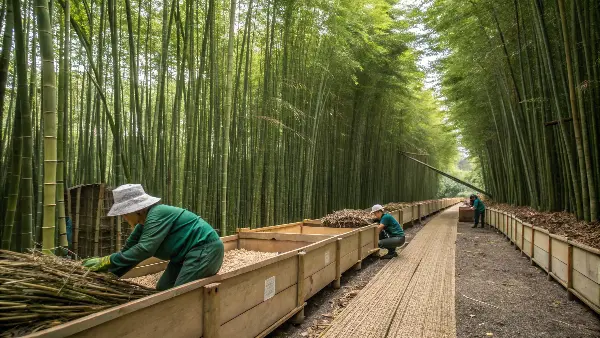
That’s the high-level view, but I know that for a professional like you, the details are what really matter. Making an informed sourcing decision requires a deeper look into each stage of the product’s life. Let’s break down the entire cycle, piece by piece, starting with the most fundamental question: its sustainability at the source. This is where the story of every great eco-product begins.
Is Harvesting Bamboo Actually Sustainable?
You have probably heard that bamboo is a miracle plant, but as a sourcing expert, you are right to be skeptical about its harvesting. Poor practices can lead to environmental damage, defeating the purpose of choosing an eco-friendly material. You need to know for certain that the bamboo you source is not causing harm to ecosystems or communities. The key to this confidence lies in understanding bamboo’s unique biology and insisting on responsible harvesting practices.
Yes, harvesting bamboo is highly sustainable when done correctly. Unlike trees, bamboo is a grass with a vast underground root system called a rhizome. When a stalk is cut, the plant itself doesn’t die. The roots remain healthy and quickly send up new shoots. This allows for frequent harvests, often every year, without needing to replant or causing soil erosion. Its rapid regeneration makes it a far more renewable resource than traditional timber, which can take decades to mature.
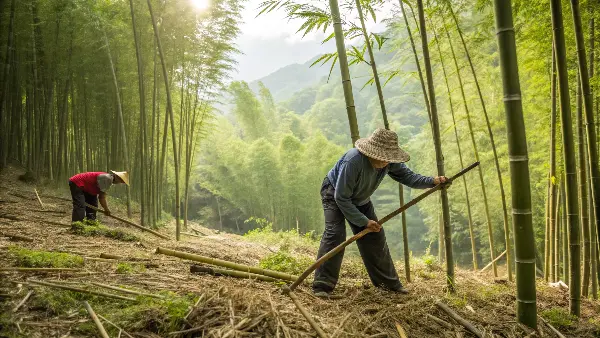
The Biology of a Super-Grass
The secret to bamboo’s sustainability is its rhizome root system. Think of it as an underground network that continuously sprouts new stalks, or culms. A single bamboo grove can produce new shoots year after year. Some species can grow up to three feet in a single day. This incredible growth rate means it can be harvested much more frequently than trees. A timber forest might take 20-50 years to mature for logging, but a bamboo grove is ready for a selective harvest in just 3-5 years. This process keeps the forest ecosystem intact, provides a continuous resource, and captures carbon dioxide much faster than many tree species.
Responsible Harvesting Practices
Sustainable harvesting is not clear-cutting. Instead, it involves selective cutting. Harvesters only take the mature culms, leaving the younger stalks and the root system undisturbed. This ensures the grove remains healthy and productive for future generations. This method also has a major environmental benefit: the dense root system is left in place, holding the soil together and preventing erosion, which is a common problem after logging. At Ecosourcecn, we partner with suppliers who follow these selective harvesting methods to ensure the long-term health of the bamboo forests.
Certification and Verification
How can you be sure your supplier is using these practices? This is where third-party certifications become essential. The Forest Stewardship Council (FSC) is a globally recognized standard for responsible forest management. FSC certification guarantees that the bamboo comes from a forest managed in an environmentally appropriate, socially beneficial, and economically viable way. For a buyer like you, demanding FSC-certified products is the easiest way to verify sustainability claims and protect your brand’s integrity. It’s a non-negotiable part of our sourcing process.
| Feature | Bamboo Harvesting | Traditional Logging |
|---|---|---|
| Regeneration | From existing root system | Replanting is required |
| Harvest Cycle | 1–5 years | 20–50+ years |
| Soil Impact | Roots prevent erosion | High risk of soil erosion |
| Ecosystem | The grove remains intact | Clear-cutting destroys habitat |
Can Bamboo Products Really Be Composted?
You have sourced a product labeled "biodegradable," but you know that term can be misleading. It doesn’t always mean the product is compostable. Your customers and waste management partners need clear answers. A product that fails to break down properly in a compost facility is just another piece of waste that can damage your brand’s reputation. Knowing the specific conditions for composting bamboo helps you make accurate claims and choose truly circular products.
Yes, natural and untreated bamboo products are fully compostable. Since bamboo is a natural plant fiber, microorganisms can easily break it down into organic matter, water, and carbon dioxide in a compost environment. However, it is vital to distinguish between raw bamboo and products made with synthetic binders or coatings. For industrial composting, certifications like BPI or TÜV Austria’s OK compost standard ensure the entire product, including any additives, will decompose safely without leaving behind harmful toxic residue.
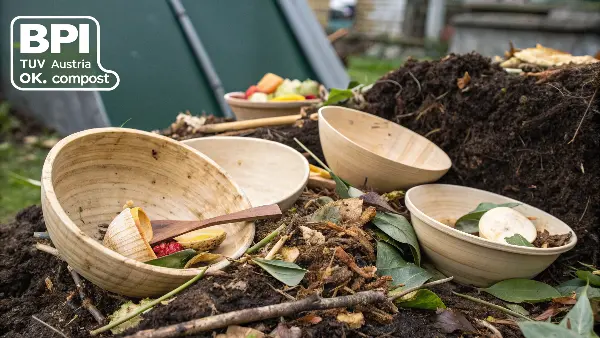
What "Compostable" Really Means
Many people use "biodegradable" and "compostable" interchangeably, but they mean very different things. A biodegradable product can be broken down by microorganisms over time, but the timeframe isn’t defined, and it can leave toxic residue. A compostable product, on the other hand, must break down within a specific timeframe (usually 90-180 days in an industrial facility) and turn into humus, a nutrient-rich soil amendment. Crucially, it must not leave any toxic material behind. This is why certifications are so important; they verify that a product meets these strict criteria.
Home vs. Industrial Composting
The right composting environment depends on the product.
- Home Composting: This works for 100% natural, untreated bamboo items like skewers, stir sticks, or cutlery. The process is slower and happens at lower temperatures. It relies on a healthy mix of "green" materials (like vegetable scraps) and "brown" materials (like your bamboo products).
- Industrial Composting: This is a large-scale, controlled process. It reaches high temperatures (over 55°C or 131°F) that are necessary to break down more complex materials, such as bioplastics like PLA which are sometimes used as a binder in bamboo fiber products.
The Role of Additives and Coatings
This is a critical detail for any sourcing specialist. Not all "bamboo" products are created equal. Some reusable bamboo cups or plates are made by mixing bamboo fiber with melamine-formaldehyde resin. This makes the product durable but also renders it non-compostable and non-recyclable. It must go to a landfill. When sourcing products, you must ask about binders. At Ecosourcecn, we focus on 100% natural bamboo or products bound with certified compostable materials like PLA.
| Product Type | Composition | Best Composting Method |
|---|---|---|
| Bamboo Cutlery | 100% Natural Bamboo | Home or Industrial |
| Reusable Bamboo Cup | Bamboo Fiber + Melamine | Not Compostable (Landfill) |
| Bamboo Fiber Plate | Bamboo Fiber + PLA | Industrial Composting Only |
| Bamboo Skewer | 100% Natural Bamboo | Home or Industrial |
What is the Scientific Process of Bamboo Decomposition?
Simply knowing something is labeled "compostable" is not enough for a technical expert. You need to understand the mechanism behind it. This knowledge helps you answer detailed questions from stakeholders, verify supplier claims, and ensure you comply with regional waste management standards. To be truly confident, let’s explore the biological and chemical processes that turn a solid bamboo product back into the earth.
Bamboo decomposes through a biological process driven by microorganisms like bacteria and fungi. These microbes use the cellulose and lignin—the main structural components of bamboo fiber—as their food source. In a compost pile with enough oxygen (an aerobic environment), they break these complex carbohydrates down into simpler molecules. This process releases carbon dioxide, water, and heat, resulting in humus, a stable, nutrient-rich organic material that improves soil health and completes the natural cycle.
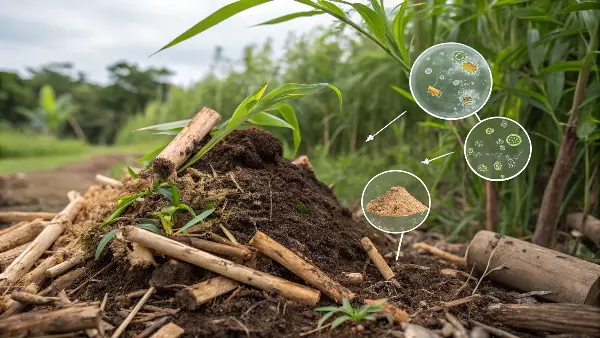
The Key Players: Microorganisms
Decomposition is a team effort. Different microbes perform different jobs.
- Bacteria: These are the initial workers. They thrive in the warm, moist conditions of a compost pile and quickly break down the most accessible compounds, like simple sugars and cellulose. They are responsible for a lot of the heat generated during composting.
- Fungi: After the bacteria have done their initial work, fungi move in. Fungi are uniquely equipped to break down the tougher, more complex components of bamboo, particularly lignin. Lignin is a tough polymer that gives wood and bamboo its rigidity. Without fungi, the decomposition process would be incredibly slow.
The Ideal Environment for Decomposition
For these microorganisms to work efficiently, they need the right conditions. This is what composting is all about: creating the perfect environment for nature to do its work.
- Carbon-to-Nitrogen (C:N) Ratio: Bamboo is very high in carbon (a "brown" material). To decompose effectively, it needs to be mixed with nitrogen-rich "green" materials like food scraps or grass clippings. An ideal C:N ratio is about 30:1.
- Moisture: Microbes need water to live and work. The compost pile should be moist, like a wrung-out sponge.
- Oxygen (Aeration): The most efficient decomposition is aerobic (with oxygen). This is why compost piles are turned regularly to allow air to circulate. Without oxygen, decomposition becomes anaerobic, which is much slower and produces methane.
From Lignocellulose to Humus
Bamboo is made of lignocellulose, a combination of lignin and cellulose. The composting journey transforms this solid structure into humus. The microorganisms first attack the cellulose, breaking it down for energy. Then, the specialist fungi tackle the lignin. As these materials decompose, they are converted into CO2, water, and a complex, stable organic substance called humus. Humus is not just dirt; it’s a valuable soil conditioner that improves soil structure, water retention, and nutrient availability for plants. This is the true meaning of a circular lifecycle.
So, How Long Does it Take for Bamboo Products to Decompose?
You need practical timelines for your sustainability reports and customer communications. Vague answers like "it depends" are not helpful and can weaken your credibility. Your partners and customers want to know what to expect. While conditions are always a factor, we can provide clear timeframes for different composting scenarios to help you set realistic expectations and manage your product’s end-of-life story properly.
The decomposition time for bamboo products varies greatly depending on the environment. In a controlled industrial composting facility, bamboo items can break down in as little as 3 to 6 months, meeting strict certification standards like EN13432. In a typical home compost bin, the process is slower and can take anywhere from 6 months to 2 years. If left in the natural environment, like a fallen branch, it could take several years to fully decompose.
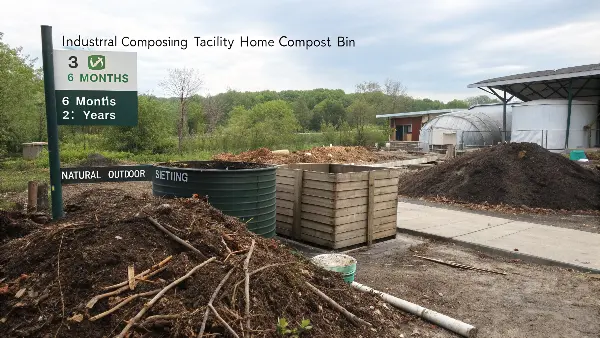
Factors Influencing Decomposition Speed
Several factors work together to determine how fast a bamboo product breaks down. Understanding these variables is key to setting clear expectations.
- Temperature: Higher temperatures accelerate microbial activity. Industrial compost facilities maintain high heat, which is why they are so much faster.
- Moisture & Oxygen: Microbes need both to thrive. A pile that is too dry or too wet and compacted (lacking oxygen) will slow decomposition dramatically.
- Particle Size: A smaller item will decompose faster than a larger one. A shredded bamboo plate has far more surface area for microbes to work on than a solid bamboo fork.
- The Mix: As mentioned, bamboo needs nitrogen-rich materials to balance its high carbon content. A well-balanced pile decomposes much more quickly.
Industrial vs. Home Composting Timelines
The disposal method is the single biggest factor in the timeline. Here are some realistic estimates.
| Composting Method | Conditions | Estimated Timeframe |
|---|---|---|
| Industrial Composting | High heat (>55°C), controlled moisture & aeration | 3–6 months |
| Well-Managed Home Compost | Variable heat, consistent moisture, and regular turning | 6–24 months |
| Poorly-Managed Home Compost | Low heat, dry or waterlogged, never turned | 2–5+ years |
| Natural Environment | Ambient conditions, exposed to elements | 2–10+ years |
What About Landfill?
This is a critical point. If a compostable bamboo product ends up in a landfill, it fails to deliver on its environmental promise. Landfills are designed for storage, not decomposition. They are packed so tightly that there is no oxygen available. In this anaerobic environment, the bamboo will break down extremely slowly over many years. Worse, as it does, it will release methane, a greenhouse gas that is over 25 times more potent than carbon dioxide. This is why proper disposal and access to composting facilities are essential to completing bamboo’s sustainable lifecycle.
Conclusion
Bamboo’s journey from a fast-growing grass to a compostable product is a powerful example of a circular economy. It starts with sustainable harvesting, becomes a useful product, and ends by returning to the earth as nutrient-rich humus. This lifecycle makes bamboo an excellent, responsible alternative to plastic for businesses committed to a greener planet.


